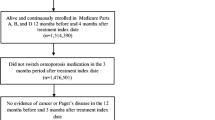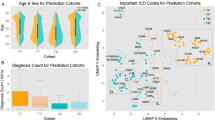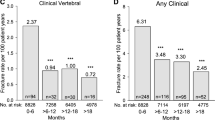Abstract
Early prevention of future fracture is an important goal in those at risk. A similar 3-year fracture efficacy is reported for most osteoporosis agents. Onset of fracture efficacy may be useful to help tailor treatment based on risk. We reviewed the peer-reviewed literature for onset of fracture efficacy data on the commonly prescribed osteoporosis treatments. All papers were reviewed independently by at least two reviewers for onset of efficacy for morphometric vertebral fracture (MVF), clinical vertebral fracture (CVF), nonvertebral fracture (NVF), hip fracture, and any clinical fracture (ACF). Alendronate is reported to reduce multiple CVF by 6 months; all CVF, NVF, and multiple ACF by 12 months; and all ACF and hip fracture by 18 months. Ibandronate is reported to reduce MVF by 12 months and NVF by 36 months. Raloxifene is reported to reduce CVF by 3–6 months and NVF by 36 months. Risedronate is reported to reduce CVF and NVF by 6 months, and hip fracture by 12 months. Strontium ranelate is reported to reduce MVF, CVF, NVF, and ACF by 12 months, and hip fracture by 36 months. Zoledronic acid is reported to reduce MVF, CVF, and ACF by 12 months, NVF by 24 months, and hip fracture by 36 months. Although direct comparisons are limited, based on the available literature, risedronate, followed by alendronate, have the earliest onset of benefit across the range of fracture types. Onset of efficacy may be an important consideration in the selection of treatment for some patients.
Similar content being viewed by others
References
World Health Organisation (2004) WHO Technical report series, no. 921
Economics Access (2001) The burden of brittle bones: costing osteoporosis in Australia. Access Economics Pty Ltd, Canberra
Cooper C (1997) The crippling consequences of fractures and their impact on quality of life. Am J Med 103:12S–17S (discussion 17S–19S)
Eisman J, Clapham S, Kehoe L (2004) Australian BoneCare Study. Osteoporosis prevalence and levels of treatment in primary care: the Australian BoneCare Study. J Bone Miner Res 19:1969–1975
Chilov MN, Cameron ID, March LM (2003) Australian National Health and Medical Research Council. Evidence-based guidelines for fixing broken hips: an update. Med J Aust 179:489–493
Nguyen TV, Center JR, Eisman JA (2004) Osteoporosis: underrated, under diagnosed and undertreated. Med J Aust 180:S18–S22
Klotzbuecher CM, Ross PD, Landsman PB, Abbott TA 3rd, Berger M (2000) Patients with prior fractures have an increased risk of future fractures: a summary of the literature and statistical synthesis. J Bone Miner Res 15:721–739
Delmas PD (2002) Treatment of postmenopausal osteoporosis. Lancet 359:2018–2026
Brooks PM, Hooper MJ, Smallwood RA (2004) Bone and joint disease: prevention and control. Med J Aust 180:S4–S5
Philips P, Braddon J (2004) Osteoporosis—diagnosis, treatment and management. Aust Fam Physician 33:111–119
Seeman E, Eisman JA (2004) Treatment of osteoporosis: why, whom, when and how to treat. The single most important consideration is the individual’s absolute risk factor. Med J Aust 180:298–303
Lindsay R, Silverman SL, Cooper C, Hanley DA, Barton I et al (2001) Risk of new vertebral fracture in the year following a fracture. JAMA 285:320–323
Black DM, Cummings SR, Karpf DB, Cauley JA, Thompson DE et al (1996) Randomised trial of effect of alendronate on risk of fracture in women with existing vertebral fractures. Lancet 348:1535–1541
Cummings SR, Black DM, Thompson DE, Applegate WB, Barrett-Connor E et al (1998) Effect of alendronate on risk of fracture in women with low bone density but without vertebral fractures: results from the Fracture Intervention Trial. JAMA 280:2077–2082
Levis S, Quandt SA, Thompson D, Scott J, Schneider DL et al (2002) Alendronate reduces the risk of multiple symptomatic fractures: results from the Fracture Intervention Trial. J Am Geriatr Soc 50:409–415
Black DM, Thompson DE, Bauer DC, Ensrud K, Musliner T et al (2000) Fracture risk reduction with alendronate in women with osteoporosis: the Fracture Interventional Trial. J Clin Endocrinol Metab 85:4118–4124
Pols HA, Felsenberg D, Hanley DA, Stepan J, Munoz-Torres M et al (1999) Multinational, placebo-controlled, randomized trial of the effects of alendronate on bone density and fracture risk in postmenopausal women with low bone mass: results of the FOSIT study. Osteoporos Int 9:461–468
Downs RW Jr, Bell NH, Ettinger MP, Walsh BW, Favus MJ et al (2000) Comparison of alendronate and intranasal calcitonin for treatment of osteoporosis in postmenopausal women. J Clin Endocrinol Metab 85:1783–1788
Reid DM, Hosking D, Kendler D, Brandi ML, Wark JD et al (2006) Alendronic acid produces greater effects than risedronic acid on bone density and turnover in postmenopausal women with osteoporosis: results of FACTS—international. Clin Drug Invest 26:63–74
Chestnut IC, Skag A, Christiansen C, Recker R, Stakkestad JA et al (2004) Effects of oral ibandronate administered daily or intermittently on fracture risk in postmenopausal osteoporosis. J Bone Miner Res 19:1241–1249
Felsenberg D, Miller P, Armbrecht G, Wilson K, Schimmer RC et al (2005) Oral ibandronate significantly reduces the risk of vertebral fractures of greater severity after 1, 2 and 3 years in postmenopausal women with osteoporosis. Bone (NY) 37:651–654
Miller PD, Epstein S, Sedarati F, Reginster JY (2008) Once-monthly oral ibandronate compared with weekly oral alendronate in postmenopausal osteoporosis: results from the head-to-head MOTION study. Curr Med Res Opin 24:207–213
Lufkin EG, Whitaker MD, Nickelsen T, Argueta R, Caplan RH et al (1998) Treatment of established postmenopausal osteoporosis with raloxifene: a randomized trial. J Bone Miner Res 13:1747–1754
Ettinger B, Black DM, Mitlak BH, Knickerbocker RK, Nickelsen T et al (1999) Reduction of vertebral fracture risk in postmenopausal women with osteoporosis treated with raloxifene: results from a 3-year randomized clinical trial. JAMA 282:637–645
Maricic M, Adachi JD, Sarkar S, Wu W, Wong M et al (2002) Early effects of raloxifene on clinical vertebral fractures at 12 months in postmenopausal women with osteoporosis. Arch Intern Med 162:1140–1143
Qu Y, Wong M, Thiebaud D, Stock JL (2005) The effect of raloxifene therapy on the risk of new clinical vertebral fractures at three and six months: a secondary analysis of the MORE trial. Curr Med Res Opin 21:1955–1959
Delmas PD, Genant HK, Crans GG, Stock JL, Wong M et al (2003) Severity of prevalent vertebral fractures and the risk of subsequent vertebral and nonvertebral fractures: results from the MORE trial. Bone (NY) 33:522–532
Harris ST, Watts NB, Genant HK, McKeever CD, Hangartner T et al (1999) Effects of risedronate treatment on vertebral and nonvertebral fractures in women with postmenopausal osteoporosis: a randomised controlled trial. JAMA 282:1344–1352
Reginster JY, Minne HW, Sorensen OH, Hooper M, Roux C et al (2000) Randomized trial of the effects of risedronate on vertebral fractures in women with established postmenopausal osteoporosis. Vertebral Efficacy with Risedronate Therapy (VERT) Study Group. Osteoporos Int 11:83–91
Ringe JD, Faber H, Farahmand P, Dorst A (2006) Efficacy of risedronate in men with primary and secondary osteoporosis: results of a 1-year study. Rheumatol Int 26:427–431
Watts NB, Lindsay R, Li Z, Kasibhatla C, Brown J (2003) Use of matched historical controls to evaluate the anti-fracture efficacy of once-a-week risedronate. Osteoporos Int 14:437–441
Watts NB, Josse RG, Hamdy RC, Hughes RA, Manhart MD et al (2003) Risedronate prevents new vertebral fractures in postmenopausal women at high risk. J Clin Endocrinol Metab 88:542–549
Boonen S, McClung MR, Eastell R, El-Haji Fuleihan G, Barton IP et al (2004) Safety and efficacy of risedronate in reducing fracture risk in osteoporotic women aged 80 and older: implications for the use of antiresorptive agents in the old and oldest old. J Am Geriatr Soc 52:1832–1839
Adachi JD, Rizzoli R, Boonen S, Li Z, Meredith MP et al (2005) Vertebral fracture risk reduction with risedronate in post-menopausal women with osteoporosis: a meta-analysis of individual patient data. Aging Clin Exp Res 17:150–156
Roux C, Seeman E, Eastell R, Adachi J, Jackson RD et al (2004) Efficacy of risedronate on clinical vertebral fractures within six months. Curr Med Res Opin 20:433–439
McClung MR, Geusens P, Miller PD, Zippel H, Bensen WG et al (2001) Effect of risedronate on the risk of hip fracture in elderly women. Hip Intervention Program Study Group. N Engl J Med 344:333–340
Harrington JT, Ste-Marie LG, Brandi ML, Civitelli R, Fardellone P et al (2004) Risedronate rapidly reduces the risk for nonvertebral fractures in women with postmenopausal osteoporosis. Calcif Tissue Int 74:129–135
Sato Y, Kanoko T, Satoh K, Iwamoto J (2005) The prevention of hip fracture with risedronate and ergocalciferol plus calcium supplementation in elderly women with Alzheimer disease. Arch Intern Med 165:1737–1742
Watts NB, Worley K, Solis A, Doyle J, Sheer R (2004) Comparison of risedronate to alendronate and calcitonin for early reduction of nonvertebral fracture risk: results from a managed care administrative claims database. J Manag Care Pharm 10:142–151
Silverman SL, Watts NB, Delmas PD, Lange JL, Lindsay R (2007) Effectiveness of bisphosphonates on nonvertebral and hip fractures in the first year of therapy: the risedronate and alendronate (REAL) cohort study. Osteoporos Int 18:25–34
Masud T, McClung M, Geusens P (2009) Reducing hip fracture risk with risedronate in elderly women with established osteoporosis. Clin Interv Aging 4:445–449
Sato Y, Iwamoto J, Kanoko T, Satoh K (2005) Risedronate sodium therapy for prevention of hip fracture in men 65 years or older after stroke. Arch Intern Med 165:1743–1748
Sato Y, Iwamoto J, Kanoko T, Satoh K (2005) Risedronate therapy for prevention of hip fracture after stroke in elderly women. Neurology 64:811–816
Sato Y, Honda Y, Iwamoto J (2007) Risedronate and ergocalciferol prevent hip fracture in elderly men with Parkinson disease. Neurology 68:911–915
Meunier PJ, Roux C, Seeman E, Ortolani S, Badurski JE et al (2004) The effects of strontium ranelate on the risk of vertebral fracture in women with postmenopausal osteoporosis. N Engl J Med 350:459–468
Reginster JY, Seeman E, De Vernejoul MC, Adami S, Compston J et al (2005) Strontium ranelate reduces the risk of nonvertebral fractures in postmenopausal women with osteoporosis: treatment of peripheral osteoporosis (TROPOS) study. J Clin Endocrinol Metab 90:2816–2822
Seeman E, Vellas B, Benhamou C, Aquino JP, Semler J et al (2006) Strontium ranelate reduces the risk of vertebral and nonvertebral fractures in women eighty years of age and older. J Bone Miner Res 21:1113–1120
Black DM, Delmas PD, Eastell R, Reid IR, Boonen S et al (2007) Once-yearly zoledronic acid for treatment of postmenopausal osteoporosis. N Engl J Med 356:1809–1822
Lyles KW, Colón-Emeric CS, Magaziner JS, Adachi JD, Pieper CF et al (2007) Zoledronic acid and clinical fractures and mortality after hip fracture. N Engl J Med 357:1799–1809
Boonen S, Black DM, Colón-Emeric CS, Eastell R, Magaziner JS et al (2010) Efficacy and safety of a once-yearly intravenous zoledronic acid 5 mg for fracture prevention in elderly postmenopausal women with osteoporosis aged 75 and older. J Am Geriatr Soc 58:292–299
Sontag A, Krege JH (2010) First fractures among postmenopausal women with osteoporosis. J Bone Miner Metab 28:485–488
Acknowledgments
This paper was funded by Sanofi-Aventis Australia through an investigator-initiated grant. Although Sanofi-Aventis had an opportunity to review the paper before publication, the authors take full responsibility for the content of the paper and have not been influenced by the sponsor.
Conflict of interest
C.A. Inderjeeth, advisory, research funding and/or speaker fees received from Amgen, Eli Lilly, Merck Sharp and Dohme, Roche/GSK Australia, Sanofi-Aventis, and Servier Laboratory Australia; K. Chan, none to declare; K. Kwan, none to declare; M. Lai, none to declare.
Author information
Authors and Affiliations
Corresponding author
About this article
Cite this article
Inderjeeth, C.A., Chan, K., Kwan, K. et al. Time to onset of efficacy in fracture reduction with current anti-osteoporosis treatments. J Bone Miner Metab 30, 493–503 (2012). https://doi.org/10.1007/s00774-012-0349-1
Received:
Accepted:
Published:
Issue Date:
DOI: https://doi.org/10.1007/s00774-012-0349-1




